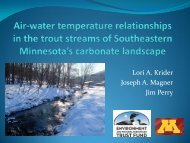Minnesota Water Resources Conference - Water Resources Center ...
Minnesota Water Resources Conference - Water Resources Center ...
Minnesota Water Resources Conference - Water Resources Center ...
Create successful ePaper yourself
Turn your PDF publications into a flip-book with our unique Google optimized e-Paper software.
BOOK OF ABSTRACTS<br />
Tuesday, Monday, October 27 23<br />
Concurrent Sessions III 3:15–4:45<br />
Track A: Low Impact Development, continued<br />
Vegetation—Can it Fix Soils in Raingardens Not in Your Lifetime!<br />
David Bauer, Rice Creek <strong>Water</strong>shed District, dbauer@ricecreek.org; Dan Wheeler, University of <strong>Minnesota</strong><br />
Planting vegetation is commonly considered an effective raingarden remediation strategy for compacted or<br />
fill soils. While vegetation has beneficial properties, it is only one of many important factors that influence<br />
water movement through soil materials. Processes that make soil more permeable in nature take hundreds<br />
to thousands of years, as shown in our native soils. Over the past few years, hundreds of rain gardens and<br />
biofiltration cells have been installed in Rice Creek <strong>Water</strong>shed District. Failures are usually linked to problems<br />
in interpreting the soils or damage to the soils during construction. Comparisons will be made to the<br />
performance standards of raingarden soils and the soil treatment areas of septic systems. Plants are important<br />
for aesthetics, filtering sediment, and trapping nutrients. Infiltration, a raingarden’s most important function in<br />
meeting Rice Creek <strong>Water</strong>shed District Stormwater Rules, is dependent on the soils.<br />
31 <strong>Minnesota</strong> <strong>Water</strong> <strong>Resources</strong> <strong>Conference</strong>, October 27–28, 2008
















